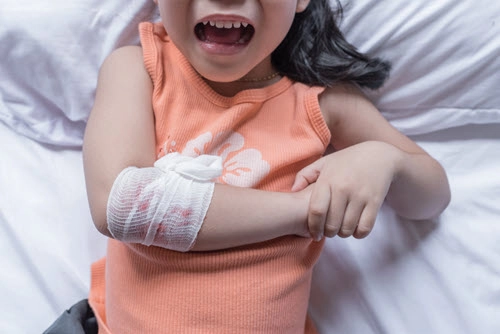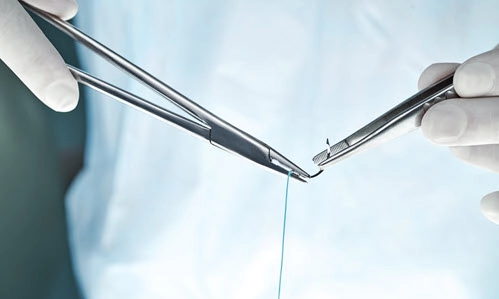Pediatric Coding Alert
Get the Answers to All Your Wound Repair Questions
“Classify, locate, add” is your formula for repaired laceration documentation.
Coding wound repairs isn’t the easiest of tasks. Finding the right code for the anatomic site being repaired may be easy enough, but making sure you add up the total lengths of the wound repairs in the same classification and anatomic site when your pediatrician makes more than one repair can create some serious coding problems.
That’s why coders have plenty of questions about this procedure, and why we’ve attempted to answer them all in this FAQ.
What Constitutes a Wound Repair?
“Understanding the definitions of the different types of laceration repairs is critical to assigning the correct CPT® codes,” says Jessica Miller, CPC, CPC-P, CGIC, manager of professional coding for Ciox Health in Alpharetta, Georgia.
“The CPT® Manual states that you should report laceration repair codes when a provider performs a wound closure using sutures, staples, or tissue adhesives, such as Dermabond®, either alone, in combination with each other, or together with adhesive strips. When providers only use adhesive strips — and no other repair material — to perform the wound closure, coders should not report laceration repair codes; instead, the closures would be coded with the appropriate evaluation and management [E/M] code,” Miller notes.

What’s the Best Way to Code a Wound Repair?
Coding wound repairs is best handled using a three-step approach. “Coders should search the provider’s documentation to decide, first, whether the wound closure is simple, intermediate, or complex; second, where the provider closed the wound on the patient’s body; and, third, the total length, measured in centimeters, of the wound closure(s),” says Mary I. Falbo, MBA, CPC, CEO of Millennium Healthcare Consulting Inc. in Lansdale, Pennsylvania
1) Assess wound complexity
First, determine the repair classification using the CPT® wound repair guidelines. A simple repair involves a wound that goes as deep as the patient’s dermis or epidermis but no deeper than the subcutaneous tissue and “without significant involvement of deeper structures,” per CPT®. A simple repair must also only involve a one-layer closure.
Intermediate repairs involve wounds that go much deeper into the “subcutaneous tissue and superficial (non-muscle) fascia,” according to CPT®, and involve “extensive cleaning or removal of particulate matter.” Closure of intermediate wounds is also single-layer.
The classification will then lead you to code groups 12001-12021 for simple wound repair and 12031-12057 for intermediate wound repair. Your pediatrician will rarely, if ever, perform a complex wound repair.
2) Choose the correct anatomic code
Both simple and intermediate repair codes are then divided into two anatomic groups: the scalp, neck, axillae, external genitalia, trunk and/or extremities including hands and feet; and the face, ears, eyelids, nose, lips and/or mucous membranes.
3) Add the total length of the repair(s) per classification and location
Suppose a patient arrives at your practice after a fall from a swing set, and your pediatrician repairs three wounds: a simple repair on the left arm that measures 11 cm; an intermediate repair on the left arm that measures 12 cm; and another intermediate repair on the left leg that measures 15 cm.
Following the classification, location, and add measurement formula, you arrive at one simple repair and two intermediate repairs (which you will add together) in the same location.
“You’ll report the single, simple repair of the left arm with 12004 [Simple repair of superficial wounds of scalp, neck, axillae, external genitalia, trunk and/or extremities (including hands and feet); 7.6 cm to 12.5 cm], given the classification [simple], the location [arm], and length [11 cm],” says Falbo.
The other repairs are a little trickier to report. “Even though there are two separate wounds, you will report them together, as they are both classified the same [intermediate] and they are both of the same anatomic category [extremities]. Because of that, you will add the lengths of the two wounds [11 cm + 15 cm = 26 cm] to arrive at 12036 [Repair, intermediate, wounds of scalp, axillae, trunk and/or extremities (excluding hands and feet); 20.1 cm to 30.0 cm],” says Falbo.
Pro coding tips: “Always list the most extensive procedure first, and remember to add modifier 59 [Distinct procedural service] to any other repairs,” says Falbo. This leaves you with a final coding for this encounter of 12036 with 12004-59.

When Do I Use a Wound Dehiscence Code?
You may also be called on to use two other wound repair codes: 12020 (Treatment of superficial wound dehiscence; simple closure) and 12021 (Treatment of superficial wound dehiscence; with packing). “You would use these codes when a provider opens up a previously sutured area that has become infected, cleans the wound, and then closes it with a simple closure [12020],” explains Miller. If the wound is really infected, the provider may decide to pack it with gauze strips (12021), leaving the wound open to allow infection to drain.
Pediatric Coding Alert
- News You Can Use:
Stay Current With the 2021 ICD-10 Addenda (Part 1)
Here are just some of the codes you’ll need to become familiar with beginning Oct. [...] - Guidelines:
Use This Guide to Make Your Way Through the 2021 ICD-10-CM Guidelines
COVID-10, vaping coding rules finalized for next year. Don’t stress about the updated guidelines to [...] - Procedure Coding:
Get the Answers to All Your Wound Repair Questions
“Classify, locate, add” is your formula for repaired laceration documentation. Coding wound repairs isn’t the [...] - You Be the Coder:
Don't Exclude This Advice from Your Dx Coding Understanding
Question: I am still confused by the Excludes1 and Excludes2 instructions in ICD-10. Can you [...] - Reader Questions:
Draw on This Advice for Accurate Venipuncture Coding
Question: Aside from the age restrictions, what is the difference between venipuncture codes 36400-36410, 36420-36425, [...] - Reader Questions:
Add CS Modifier to E/M, COVID-19 Tests Only in This Encounter
Question: One of our private insurers is requiring us to append modifier CS to all [...] - Reader Questions:
Turn to Destruction Codes for Chemical Lesion Removal
Question: I am confused about which CPT® code to use for milia destruction and the [...]

